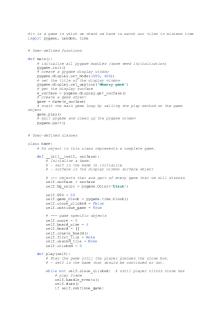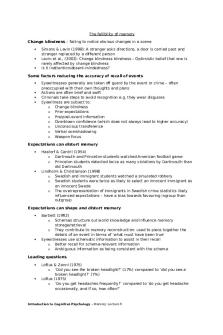Week 3 epa - memory PDF

| Title | Week 3 epa - memory |
|---|---|
| Author | Ellie Carroll |
| Course | Exploring Psychological Approaches |
| Institution | London South Bank University |
| Pages | 3 |
| File Size | 119.5 KB |
| File Type | |
| Total Downloads | 77 |
| Total Views | 160 |
Summary
memory models and key studies linked ...
Description
EPA lecture three – memory Week 3 13/02/2020 Memory - the ability to retain information of past events, based on the individual’s ability to encode and retain information across a time period and be able to retrieve this information after. Divisions of memory Memory has two main parts short-term memory (STM) and long-term memory (LTM), these areas rely on one another within the brain area. STM is a temporary store this can hold up to a small amount of information in a short time period. When attention is given to something, it enters STM until we attend to something else. Working memory Often working memory is compared to a computer as the brain has a similar way of processing information. There is an input, storage and then an output. However, making a computer analogy can be criticised as the analogy be too simplistic in comparison to the full brain process. It has been demonstrated that people with good working memory are able to do more things at once. Working memory is active memory for the information that is currently being processed, when information is manipulated it needs the working memory model capacity. The working memory model was developed as a criticism of the multi-store model, as Baddeley stated that STM is more active than what it was being represented. Diagram Central Executive
Visuospatial sketch pad
Phonological loop
Episodic Buffer
Central executive directs resources to the “slave” systems (Visuospatial sketchpad, the Phonological loop, and the Episodic Buffer). The visuospatial sketchpad stores visual and spatial information (imagine an imagine and turning it 180 degrees), the phonological loop stores sounds and the episodic buffer stores information that has been remembered from our past. This evidence comes from the ‘dual task’ studies, this is where researchers ran interference tests before the information that the participant was trying to remember, and the distracting information are needed to use the phonological loop to its full potential. If doing a task that involves the visuo-spatial sketch pad the participant would experience less interference. This is due to using two different stores at the same time, which lessens the
stress of processing information allowing less interference. Being able to select some information is important for working memory. The cognitive neuroscience of working memory There is a wide variety of evidence that states that the prefrontal cortex (PFC) supports working memory. D’Esposito and Postle (2015) suggested that the PFC represents that central executive. This is because it has the potential to control over behaviour, biasing the quality of memory and setting subordinate standards. The PFC is a likely part of the networking regions that are involved in working memory (there is active research still going on). Eriksson et al (2015) suggested that working memory involved areas that are involved in attention and perceptual and memory systems. The subcortical structures are also implicated within this process. Long term memory Atkinson and Shiffrin (1968) stated that some of the information put into STM can be passed on to long term memory (LTM) for storage. Memory consolidation is referring to the process which a temporary memory is transformed into a more stable and long-lasting form. Whereas retrieval is the recovery of the stored information so that it can be reused or to influence future behaviour. For example, if a dog bites a wire and gets an electric shock it mostly likely will not do it again. Diagram to LTM
Long Term Memory
Non-Declarative / Implicit Memory
Procedural Learning
Priming
Declarative / Implicit Memory
Conditioning
Episodic Memory
Semantic Memory
Non-Declarative memory refers to the things we cannot say. Procedural learning includes motor skills like learning how to ride a bike. Priming is an enhancement of our ability to think of a stimulus due to previous experience or exposure. Conditioning is learning through simple associations between items and responses. Declarative memory refers to memory of things that we can say. Episodic memory is the collection of past personal events that have happened in a certain time and place. Whereas semantic memory is based on knowledge and facts about the world. We know that episodic memory and semantic memory are separate stores because patients can lose their ability to remember the events in their lives but still know facts about the world (this can also happen the other way). Damage to the hippocampus is associated with problems in the episodic memory, but not semantic memory. Whereas damage to the temporal poles is associated with semantic memory but not with episodic memory. To further support the knowledge of
separate stores we can look at brain imagining as evidence, we can identify a large network of regions that become active during both episodic and semantic memory. Memory retrieval Information, which is retrieved from episodic memory, it is reactivated in working memory in the episodic buffer. Every time you remember an event you adjust that memory from outside influences, every time you bring a memory back, you will strengthen the memory. This idea can be supported by Karpicke and Roediger (2007 and 2008). However, when retrieving memories, they can become distorted, like perception episodic memory is a constructive process. Flashbulb memories These are vivid memories linked to important and unexpected events (Brown and Kulik, 1977), for example, everyone can tell you where they were when they found out about 9/11. It explained by the emotional arousal of the events, emotion is likely to focus attention on the event which should improve memory. This can be supported by Loftus et al weapons focus study. It was also suggested that emotions may have a biological impact on memory too. For example, a traumatic event like rape may cause the individual stress which could impact their biological structure. In contrast to this more recent research suggests that Flashbulb memories may not be as accurate as they feel. From the finding flashbulb memories were susceptible to different types of errors that influence and distort everyday memories. Everyone felt that they could remember when people forgot more ordinary memories, yet people were confident in their reports. Flashbulb memories can become distorted by the influence from outside sources, for example, the news and the influence of other opinions. Episodic memory and semantic memory also relate to flashbulb memory, so hearing about 9/11 and describing what you were doping when you heard about it would be classed as episodic whereas if you said what had happened in the event like airline hijacking that would be classed as semantic memory....
Similar Free PDFs

Week 3 epa - memory
- 3 Pages

Week 3- Memory and intelligence
- 7 Pages

Epa-io-3.4 - Metales
- 30 Pages

EPA - Estatutos
- 24 Pages

10 EPA Method 4251 - MEtodo EPA
- 2 Pages

CAL EPA ID number
- 1 Pages

CASO EPA Colombia tatiana
- 7 Pages

Memory
- 3 Pages

Memory
- 5 Pages

Chapter 3 Learning and Memory
- 20 Pages

Epa - Batería de preguntas
- 11 Pages

EPA - (Sintaxis pseudocodigo)
- 3 Pages

In Week 3 - Week 3
- 1 Pages

Computer Memory - Lecture notes 3
- 13 Pages

Guidebook - Final - EPA
- 73 Pages
Popular Institutions
- Tinajero National High School - Annex
- Politeknik Caltex Riau
- Yokohama City University
- SGT University
- University of Al-Qadisiyah
- Divine Word College of Vigan
- Techniek College Rotterdam
- Universidade de Santiago
- Universiti Teknologi MARA Cawangan Johor Kampus Pasir Gudang
- Poltekkes Kemenkes Yogyakarta
- Baguio City National High School
- Colegio san marcos
- preparatoria uno
- Centro de Bachillerato Tecnológico Industrial y de Servicios No. 107
- Dalian Maritime University
- Quang Trung Secondary School
- Colegio Tecnológico en Informática
- Corporación Regional de Educación Superior
- Grupo CEDVA
- Dar Al Uloom University
- Centro de Estudios Preuniversitarios de la Universidad Nacional de Ingeniería
- 上智大学
- Aakash International School, Nuna Majara
- San Felipe Neri Catholic School
- Kang Chiao International School - New Taipei City
- Misamis Occidental National High School
- Institución Educativa Escuela Normal Juan Ladrilleros
- Kolehiyo ng Pantukan
- Batanes State College
- Instituto Continental
- Sekolah Menengah Kejuruan Kesehatan Kaltara (Tarakan)
- Colegio de La Inmaculada Concepcion - Cebu
